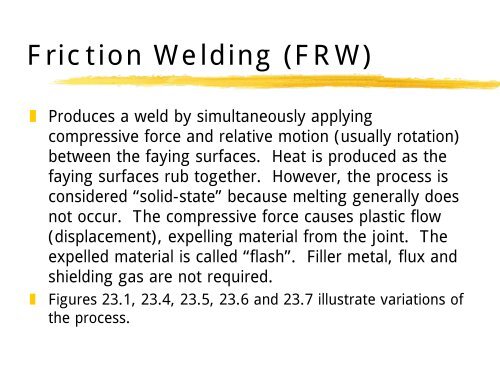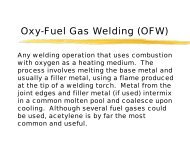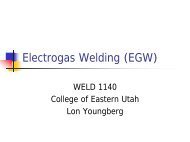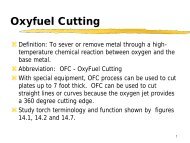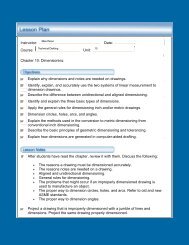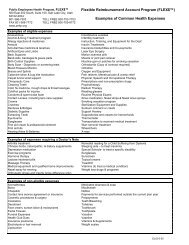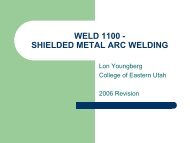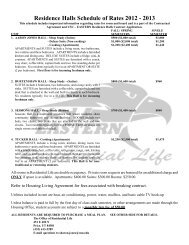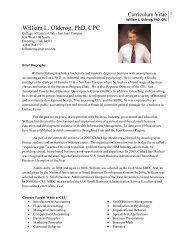Friction Welding (FRW)
Friction Welding (FRW)
Friction Welding (FRW)
Create successful ePaper yourself
Turn your PDF publications into a flip-book with our unique Google optimized e-Paper software.
<strong>Friction</strong> <strong>Welding</strong> (<strong>FRW</strong>)<br />
Produces a weld by simultaneously applying<br />
compressive force and relative motion (usually rotation)<br />
between the faying surfaces. Heat is produced as the<br />
faying surfaces rub together. However, the process is<br />
considered “solid-state” because melting generally does<br />
not occur. The compressive force causes plastic flow<br />
(displacement), expelling material from the joint. The<br />
expelled material is called “flash”. Filler metal, flux and<br />
shielding gas are not required.<br />
Figures 23.1, 23.4, 23.5, 23.6 and 23.7 illustrate variations of<br />
the process.
Energy Input Methods<br />
Direct Drive <strong>Welding</strong> (conventional) - One workpiece is<br />
restrained while the other is attached directly to a motor<br />
drive unit.<br />
Inertia Drive <strong>Welding</strong> (flywheel) - One workpiece is<br />
restrained and the other is attached to a flywheel.<br />
Note: Flywheels are devices used to store kinetic energy.<br />
For instance, a small motor can be used to rotate a<br />
relatively large and heavy wheel. Once the wheel is at full<br />
speed, the energy stored within it can be used to perform<br />
work that the small motor is not capable of doing by itself.
Types of Relative Motion<br />
Most friction welding is performed by holding one of the<br />
two workpieces stationary while the other is rotated<br />
about an axis of symmetry with the faying surfaces<br />
perpendicular to that axis. (See figures 23.1 and 23.4.)<br />
Other types of motion include:<br />
Radial - figure 23.5<br />
Orbital - figure 23.6<br />
<strong>Friction</strong> - figure 23.7A<br />
Angular Reciprocating - figure 23.7B<br />
Linear Reciprocating - figure 23.7C
Process Characterization<br />
2 Main Mechanisms (fig. 23.2 & 23.3):<br />
<strong>Friction</strong> Stage<br />
Forging Stage<br />
Primary Process Variables:<br />
Speed<br />
Pressure<br />
Time
<strong>Friction</strong> <strong>Welding</strong> Advantages<br />
No filler metal needed.<br />
Flux and shielding gas not required.<br />
Environmentally clean (no arc, sparks, smoke or fumes).<br />
Surface cleanliness not as critical as some processes.<br />
Narrow heat-affected zone (HAZ)<br />
Suitable for most materials and many dissimilar<br />
combinations.<br />
Less operator skill required.<br />
Good for mass production. (drill bits)<br />
Rapid process.
<strong>Friction</strong> <strong>Welding</strong> Limitations<br />
One workpiece must have an axis of symmetry that it<br />
can be rotated about.<br />
Preparation and alignment are critical.<br />
High equipment and tooling costs.<br />
Some materials cannot be friction welded.<br />
Special machines required for parts longer than 3-foot.<br />
Process turns the grain direction 90º creating potential<br />
for preferential corrosion.<br />
• Source (all slides) - AWS Handbook, Volume 2, eighth edition.


